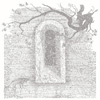Steve Noble & Stephen O'Malley, "St. Francis Duo"
 Æthenor’s En Form for Blå was one of my favorite albums of 2011, and it was the first time Stephen O’Malley and Steve Noble collaborated on record. St. Francis Duo documents their second meeting, a pair of live performances at London’s Cafe OTO recorded over two nights in August, 2010. With only guitar, percussion, and some distortion, O’Malley and Noble punch out over an hour of very raw and dynamic improvised music. Like their work together in Æthenor, it hews closer to the rock spectrum than to jazz or other kinds of improvised music, but it is their quieter interactions that make this album so satisfying.
Æthenor’s En Form for Blå was one of my favorite albums of 2011, and it was the first time Stephen O’Malley and Steve Noble collaborated on record. St. Francis Duo documents their second meeting, a pair of live performances at London’s Cafe OTO recorded over two nights in August, 2010. With only guitar, percussion, and some distortion, O’Malley and Noble punch out over an hour of very raw and dynamic improvised music. Like their work together in Æthenor, it hews closer to the rock spectrum than to jazz or other kinds of improvised music, but it is their quieter interactions that make this album so satisfying.
I was blown away by Noble’s performance on Æthenor’s En Form for Blå. His drumming made that album, in part because it provided such a strong foundation for his band mates. It was also virtuosic, meticulous, and totally unique. Noble brings that same leadership and energy to St. Francis Duo, which was recorded with Stephen O’Malley at Cafe OTO two months after the En Form sessions ended. But, when I read that Daniel O'Sullivan and Kristoffer Rygg were not involved, I wondered just how Noble and O’Malley were going to react to each other. I imagined droning feedback and whirlwind percussion passing like ships in the night.
St. Francis Duo sounds excellent, though, and it sounds excellent because Noble and O’Malley find a subtle way to make their styles work together. From beat one Noble makes it clear that he’s not going to be swallowed up by O’Malley’s guitar. He pounds out loud, absolutely manic rhythms on his toms, snare, and cymbals for close to three minutes before settling into a dizzying procession of smaller percussive noises. Throughout the record, he answers O’Malley’s more frenzied moments with huge slashes of reverberating metal, thumping bass kicks, and generally unhinged fills, but he also directs the action with his battery of brushes, wires, tuning forks, and rattles.
O’Malley also begins furiously, with feedback and in-the-red string mashing. When Noble shifts gears, he reacts coolly. He turns down the volume and dials back the intensity, switching to a series of slowly played half-melodies made up of dissonance and little bouts of fumbled rhythm. As time passes and Noble moves further into the spotlight, Stephen’s playing becomes close to silent, and there are times when I can almost hear him deciding to pluck a string. Noble’s playing remains tense and propulsive, though, even when O’Malley is at his most reserved. He provides a feeling of forward motion with every sound he makes, even the tiniest ones, so that by the end of the first set he’s put the duo in an ambiguous place. This is improvised music, but with a heavy metal feel that comes almost entirely from the drummer, who is probably best known for playing with musicians like Derek Bailey, Lol Coxhill, John Edwards, and Alex Ward. Hearing him work with O’Malley in this style is awesome, and it further convinces me that he’s one of the best percussionists going.
On the second night, O’Malley returns the favor as the music veers a little further away from the rock ‘n’ roll vibe. Steve and Stephen still give the audience some noisy passages to chew on (side D closes the album with a bang), but the best action takes place when O’Malley opens his playing up even more and ventures into atmospheric territory. Stephen’s restraint gives Noble the chance to show off his dynamics more, but it also forces him to play the guitar in a way I’ve never heard him play it, and it sounds great. He still pulls a drone and a chord or two from his six-string, but without high volumes to lean on, he has to find other ways to respond to Noble’s never-ending variations. I can’t tell for sure, but I think O’Malley might have even stuck a fork or screwdriver between his strings at one point, perhaps imitating the way Noble treats his drums. Should O’Malley choose to continue down this path on future recordings, I would be anxious to hear it. St. Francis Duo is more strong evidence that he doesn't need robes or amps that go to eleven to make great music.
samples:
 




